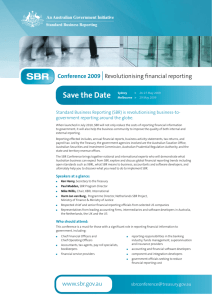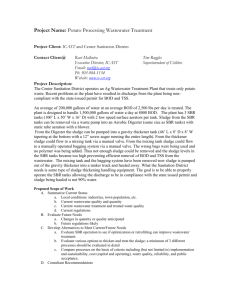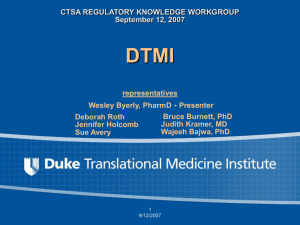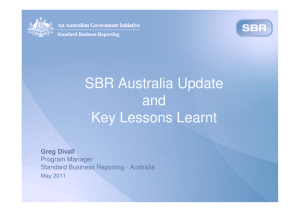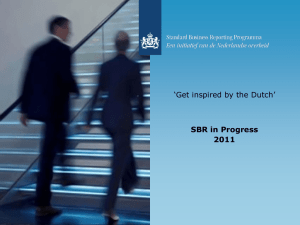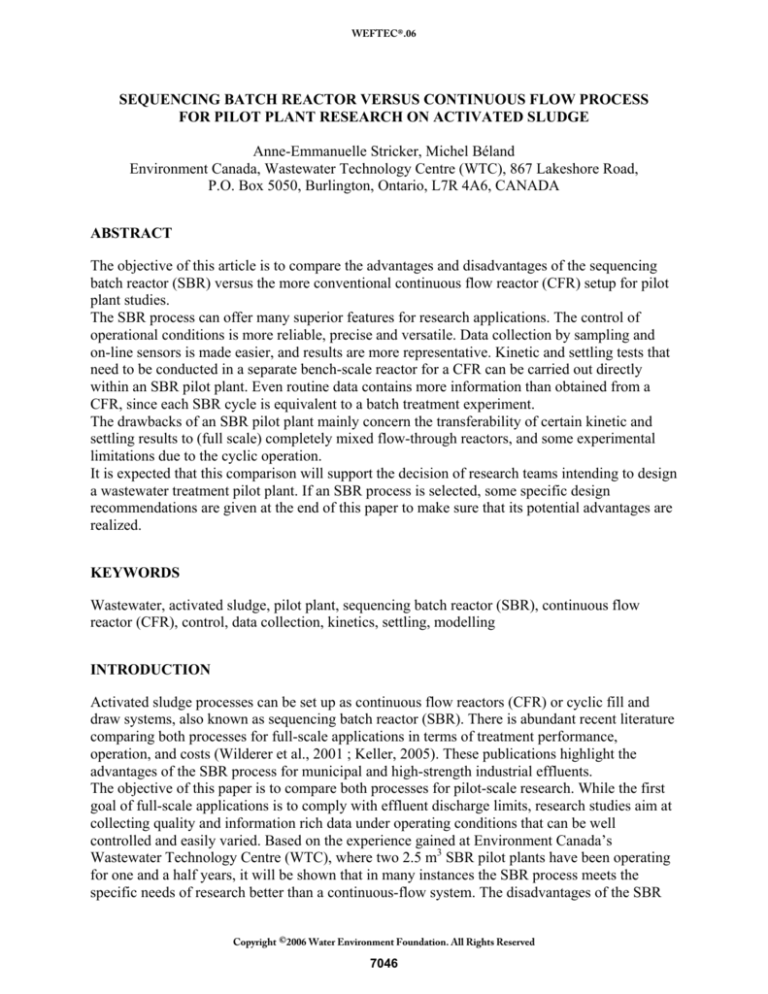
WEFTEC®.06
SEQUENCING BATCH REACTOR VERSUS CONTINUOUS FLOW PROCESS
FOR PILOT PLANT RESEARCH ON ACTIVATED SLUDGE
Anne-Emmanuelle Stricker, Michel Béland
Environment Canada, Wastewater Technology Centre (WTC), 867 Lakeshore Road,
P.O. Box 5050, Burlington, Ontario, L7R 4A6, CANADA
ABSTRACT
The objective of this article is to compare the advantages and disadvantages of the sequencing
batch reactor (SBR) versus the more conventional continuous flow reactor (CFR) setup for pilot
plant studies.
The SBR process can offer many superior features for research applications. The control of
operational conditions is more reliable, precise and versatile. Data collection by sampling and
on-line sensors is made easier, and results are more representative. Kinetic and settling tests that
need to be conducted in a separate bench-scale reactor for a CFR can be carried out directly
within an SBR pilot plant. Even routine data contains more information than obtained from a
CFR, since each SBR cycle is equivalent to a batch treatment experiment.
The drawbacks of an SBR pilot plant mainly concern the transferability of certain kinetic and
settling results to (full scale) completely mixed flow-through reactors, and some experimental
limitations due to the cyclic operation.
It is expected that this comparison will support the decision of research teams intending to design
a wastewater treatment pilot plant. If an SBR process is selected, some specific design
recommendations are given at the end of this paper to make sure that its potential advantages are
realized.
KEYWORDS
Wastewater, activated sludge, pilot plant, sequencing batch reactor (SBR), continuous flow
reactor (CFR), control, data collection, kinetics, settling, modelling
INTRODUCTION
Activated sludge processes can be set up as continuous flow reactors (CFR) or cyclic fill and
draw systems, also known as sequencing batch reactor (SBR). There is abundant recent literature
comparing both processes for full-scale applications in terms of treatment performance,
operation, and costs (Wilderer et al., 2001 ; Keller, 2005). These publications highlight the
advantages of the SBR process for municipal and high-strength industrial effluents.
The objective of this paper is to compare both processes for pilot-scale research. While the first
goal of full-scale applications is to comply with effluent discharge limits, research studies aim at
collecting quality and information rich data under operating conditions that can be well
controlled and easily varied. Based on the experience gained at Environment Canada’s
Wastewater Technology Centre (WTC), where two 2.5 m3 SBR pilot plants have been operating
for one and a half years, it will be shown that in many instances the SBR process meets the
specific needs of research better than a continuous-flow system. The disadvantages of the SBR
Copyright ©2006 Water Environment Foundation. All Rights Reserved
7046
WEFTEC®.06
process will also be discussed. Finally some design recommendations are included for
researchers who are considering building an SBR pilot plant.
For clarification the SBR-specific operation terms used through the article are defined below.
One cycle is the repetitive operational time period, and is split into the following sequences:
Table 1 – Definition of an SBR cycle setup
One cycle
Sequences
Feed
React
Waste
Settle Decant
yes
no
no
no
no
Influent flow
no
no
yes
no
no
Wastage flow
no
no
no
no
yes
Effluent flow
any pattern
any pattern
any pattern
off
off
Aeration
any pattern must be on if aeration off must be on if aeration off
off
off
Mixing
FLEXIBILITY AND CONTROL OF OPERATING PARAMETERS
Process layout. The flexibility of the SBR process highlighted in the literature for full-scale
plants applies at pilot-scale as well. It can be operated as nitrifying only (aerobic), or
nitrifying/denitrifying (anoxic/aerobic), or full BNR (anoxic/anaerobic/aerobic) by changing the
process control parameters of the Feed and React sequences alone. The same modifications on a
CFR require adding/removing tanks in series and recycle pumps for anaerobic/anoxic zones.
The ratio between anaerobic, anoxic and aerobic sludge residence times (SRT) can also be easily
varied on an SBR by adapting the duration of the aerated/non-aerated periods. On a CFR this
requires modifying the volume of each tank.
These operational changes can thus be done within a few minutes in the programming of an
SBR, in the control interface, or through timers if it is more basic. On a CFR pilot plant they
require more labour-intensive and time-consuming hardware modifications.
Inflow and outflow volumes. In an SBR the feed, wastage and effluent volumes are controlled
by level only, and thus are not flowrate dependent. As a consequence, they are accurately known,
perfectly repeatable between cycles, and can be easily modified by changing level setpoints.
A CFR pilot plant is usually fed by a pump. The daily volumes are thus determined by its
flowrate, which is more difficult to measure, to adjust, and is subject to drift.
Sludge residence time. For research applications, the SRT of the pilot plant must be wellknown, and in many cases also controlled to a set value. Using the conventional formula, SRT is
defined as:
SRT =
m MLTSS
FWAS + FEFF
Equation 1
where mMLTSS is the average total mass of mixed liquor total suspended solids (MLTSS) in the
system and FWAS and FEFF are the daily mass flows of total suspended solids (TSS) lost through
wastage and effluent.
Copyright ©2006 Water Environment Foundation. All Rights Reserved
7047
WEFTEC®.06
In an SBR where the sludge is contained in one single tank, the determination of the average
total sludge mass in the system is straightforward through regular monitoring of the MLTSS
concentration during mixed sequences, by sampling or with an on-line probe. As a consequence
it is also easy to control the SRT of an SBR pilot plant to a precise value, as already mentioned
in WERF (2003).
SRT control can even be completely independent of the MLTSS, and solely based on the
wastage volume. The key is to waste during a mixed sequence, as opposed to a settling sequence,
so that the concentration of WAS is equal to that of mixed liquor. Also, subsequent to completely
quiescent settling and provided decanting occurs from the top layer, the SBR effluent TSS
concentration is very low. It can either be neglected, or approximated by the non-settleable
fraction of the mixed liquor (fns). Equation 1 then simplifies into :
SRT =
n ⋅ (VWAS
VT
+ fns ⋅ VEFF )
Equation 2
where VT is the full volume of the reactor tank, VWAS is the volume of mixed liquor wasted at
each cycle, VEFF is the volume decanted at each cycle, and n is the number of cycles per day.
In a CFR, SRT determination and control is more complex and less accurate. The mixed liquor
may be split between several tanks in series, where concentrations are not identical due to feed
and recycle streams. Thus each single tank should be monitored for MLTSS. The determination
of the sludge mass stored in the clarifier, which is not negligible compared to the mass in the
tanks (15 to 30% in Marquot et al. (2005)), is even more problematic. One method is to establish
vertical TSS profiles in the clarifier, and estimate the total mass by multiplying each layer
volume by its concentration. TSS profiles can be obtained either manually like in Marquot et al.
(2005), which is labour intensive, or with a vertically moving probe that is costly and tricky to
install as experienced by Rouleau et al. (1997). Another approach is to mix the content of the
clarifier to take a sample for analysis like in Choubert et al. (2005), but this disturbs the process.
Even if one chooses to waste from a mixed tank instead of the clarifier, and the MLTSS
concentration is assumed to be the same in all tanks, and negligible in the effluent, Equation 1
cannot be simplified to cancel MLTSS, because the sludge mass stored in the clarifier is not
proportional to MLTSS:
SRT =
VT + mclarifier CT
Equation 3
VWAS
where CT is the average MLTSS concentration and VT the total volume of the mixed tanks in
series.
EXPERIMENTAL MASS BALANCE CALCULATIONS
The general experimental mass balance (MB) equation for a given compound over a time period
Δt = t2-t1 is expressed as:
Copyright ©2006 Water Environment Foundation. All Rights Reserved
7048
WEFTEC®.06
MB (Δt ) = m(t2 ) − m(t1 ) = VINF .C INF − VWAS .C WAS − VEFF .C EFF + mr
Equation 4
where m is the total mass of the compound in the system, C is its average concentration
measured on a flow-proportional composite sample of the stream specified in subscript, and mr is
the mass transformed through reactive processes (negative if removed, positive if generated).
For a conservative compound (mr =0) such as total phosphorus, comparing the left and righthand side terms of equation 4 helps to check consistency of sampling and analysis (C), and flow
control (V). Subsequently to this verification, the equation can be used on reactive compounds to
study their overall fate in the system, and more specifically to determine mr.
Assessment of total mass variation. Under true steady-state conditions, MB(Δt) should be zero.
However even pilot plants are never under perfect steady-state conditions, so the mass variation
may have to be considered. In an SBR, the total mass at t1 and t2 is known by simply grabbing
and analysing a representative sample of the tank content as long as t1 and t2 occur during a
mixed sequence. In a CFR pilot plant, the total mass is again difficult to determine because of the
non-mixed clarifier, specifically for compounds in the solid phase. Therefore the mass variation
is often neglected compared to other terms of the equation. However this does not necessarily
hold true, specifically for particulate compounds since Δt is usually much shorter than SRT.
Assessment of mass flows. Except for large size pilot plants, influent, wastage and effluent
volumes are usually small enough to be stored in side tanks over the whole period of sampling. A
representative sample can then be obtained by simply taking a grab sample in each storage tank.
For a CFR pilot plant however, some preservation issues may arise on the feed tank: if the
sampling period is longer than one hour, the wastewater composition may change over time and
feed tank refrigeration (Choubert et al., 2005) and/or composite sampling may become
necessary. This problem may be avoided in an SBR by introducing the whole Feed volume
within a very short period (minutes). Also, keeping the Feed sequence very short represents a
true batch operation, which enhances the benefits of the SBR process for operation (increased
feast/famine conditions) and research (each cycle is equivalent to a batch treatment experiment).
Furthermore, the hydrodynamics and residence time distribution in a CFR make it a challenge to
collect an effluent sample that is truly representative of the influent load over the considered Δt.
In an SBR, the residence time is accurately defined within a cycle, and the effluent sampled over
the Decant sequence will be truly representative of the influent sampled over the associated Feed
sequence.
KINETIC MEASUREMENTS
In situ degradation rates. During the React sequence, an SBR operates like a closed batch
reactor (VINF = VWAS = VEFF = 0), so Equation 4 simplifies to:
m(t2 ) − m(t1 ) = mr
Equation 5
which is equivalent to:
Copyright ©2006 Water Environment Foundation. All Rights Reserved
7049
WEFTEC®.06
[CT (t2 ) − CT (t1 )] = rΔt
Equation 6
where r is the average reaction rate of the compound over Δt.
Thus reaction rates can be measured directly by monitoring concentration changes in the reactor
tank by manual sampling or with an on-line probe. Environmental conditions affecting the
reaction rate such as temperature, DO, pH, substrate concentrations and mixing rate are truly
representative of the process. To obtain additional kinetic information, these parameters can also
be modified temporarily to a certain extent through controls or chemical additions. Figure 1
shows an example of a maximum nitrification rate measurement performed directly in one of the
SBR pilot plants at WTC after spiking it with ammonium chloride:
Figure 1 - Maximum nitrification rate measured directly in an SBR pilot plant
22
Result : rN = 7.2 mgN/(L.hr)
Temp. = 21.5 C, SRT = 10 d
20
NOx
Nitrogen concentrations (mgN/L)
18
16
NO3
14
NH4
12
10
8
6
4
2
NH4Cl
injection
0
09:45
NO2
10:00
10:15
10:30
10:45
11:00
11:15
Time (hh:mm)
In a CFR pilot plant, continuous mass transfer associated to the continuous flow regime prevents
in-situ measurements of process kinetics. They must be performed in a separate bench-scale
batch reactor. The setup of this second reactor is usually time-consuming and costly as it needs
itself monitoring and control equipment for environmental parameters that influence the kinetics
(at least temperature and DO). In addition, due to scaling issues, the mixing conditions in the
bench-scale batch reactor do not usually match those of the actual pilot plant. As mixing can
influence kinetics, the results obtained in the secondary batch reactor may not be representative.
Dynamic on-line profiles. Similarly, on-line data recorded on an SBR pilot plant are more
information rich and easier to interpret than in a CFR because they directly reflect process
kinetics without influence of incoming load and recycle streams (Keller, 2005). Figure 2 shows
an example of pH and DO pattern over one cycle in an SBR pilot plant at WTC:
Copyright ©2006 Water Environment Foundation. All Rights Reserved
7050
WEFTEC®.06
WASTE
Figure 2 - On-line DO and pH pattern over one SBR cycle
8
FEED
7.2
SETTLE
REACT
6
7.1
DO
Blower (run + speed)
pH
7.0
5
start of
denitrification
6.9
4
end of
nitrification
3
pH (-)
DO (mgO2/L) and blower setting (0-1)
7
DECANT
6.8
2
6.7
1
0
17:30
18:30
19:30
20:30
6.6
21:30
Time (hh:mm)
The following stages can be identified:
1. The initial alkalinity input from the feed wastewater causes the pH to increase. The DO
initially increases through the mere effect of mixing the oxygen-depleted bottom sludge
layer and the oxygen-rich supernatant.
2. Nitrification starts immediately at Feed, and its alkalinity consumption causes the pH to
decrease steadily.
3. The end of nitrification is detected by the inflection point on the DO and confirmed by
the pH trend inversion.
4. From this point, CO2 stripping by fine bubble aeration becomes the main process acting
on pH, increasing it.
5. When aeration is stopped but DO is still present, the CO2 produced by the aerobic
metabolism of biomass accumulates and acidifies the media.
6. The last trend inversion on pH indicates the switch to an anoxic metabolism
(denitrification) that releases alkalinity. DO does not seem to have reached zero yet, but
this is an artefact: the oxygen probe response becomes slower in the low DO range, while
the pH probe keeps its lower lag.
This information is very valuable for model calibration (Corominas et al., 2005) and reduces the
requirements for additional sampling compared to a CFR.
In-situ respirometry. In the example above, the Feed and React sequences were aerated
continuously. However if aeration is operated in an on-off mode, while mixing is maintained on
during non-aerated times, then the DO profiles may be used directly to establish the oxygen
uptake rate (OUR). The only error factor may be the slight surface oxygen transfer induced by
mechanical mixing during the non-aerated period. The surface oxygen transfer rate could be
measured under process conditions, and added to the DO slope for a better estimate of OUR.
Copyright ©2006 Water Environment Foundation. All Rights Reserved
7051
WEFTEC®.06
The best set-up to establish an on-line respirogram would be to control aeration between two DO
setpoints, and to automate the slope calculation and correction. This information can then be
used to characterize the influent and the biomass, and is very valuable for simulation purposes.
Again in a CFR pilot plant, respiration can only be measured in a separate batch reactor,
requiring duplicate equipment. Even though a side loop reactor setup can be automated to obtain
a continuous respirogram, data interpretation is more complex due to the continuous feed and
recycle inputs.
MEASUREMENT OF SLUDGE SETTLING CHARACTERISTICS
In an SBR pilot plant, settling velocities under ideal quiescent conditions can be studied directly
in the tank during the settling sequence by monitoring the sludge blanket level as shown in
Figure 3 and 4.
Figure 3 - Simultaneous settling test in an SBR pilot plant tank and in a bench cylinder –
Absolute results
1200
1100
1 Litre Cylinder
Sludge Blanket Level (mm)
1000
Hindered settling velocity
in tank : 140 m/d
SBR1 TANK
900
800
700
Hindered settling velocity
in cylinder : 97 m/d, due to
stronger wall effect
600
500
400
300
200
100
0
0:00
0:10
0:20
0:30
0:40
0:50
1:00
1:10
1:20
1:30
1:40
1:50
Time elapsed (h:mm)
In a CFR, the particles in the clarifier are constantly under simultaneous influence of hydraulics
and settling. The only way to assess settling parameters is to perform bench measurements in a
graduated glass cylinder. However Figures 3 and 4 show that this method can underestimate
actual settling characteristics due to the differences in container geometry. The cylinder
(typically 1L) has a higher surface area to volume ratio, which slows down the hindered settling
velocity through increased friction (“wall effect”). The cylinder also has a lower water column
height (in this case 31% of the reactor height), resulting in a lower compaction ratio since the
weight of the sludge per unit of surface area is lower.
Copyright ©2006 Water Environment Foundation. All Rights Reserved
7052
WEFTEC®.06
Figure 4 - Simultaneous settling test in an SBR pilot plant tank and in a bench cylinder –
Relative results
Sludge Blanket Level / Initial sludge level (-)
1.0
0.9
1 Litre Cylinder
SBR1 TANK
0.8
0.7
0.6
0.5
Cylinder final compaction
factor : 5.3, due to lower
sludge weight in the water
column
0.4
0.3
0.2
0.1
0.0
0:00
Tank final compaction
factor : 6.0
0:10
0:20
0:30
0:40
0:50
1:00
1:10
1:20
1:30
1:40
1:50
Time elapsed (h:mm)
DISADVANTAGES OF SBR VERSUS CFR FOR ACTIVATED SLUDGE RESEARCH
SBR pilot plants also have some disadvantages for research compared to a CFR pilot plant. They
are discussed below.
Applicability of results. The transferability of the results to full scale CFR, which predominate
among activated sludge plants, needs to be addressed. As emphasized in literature (Orhon et al.,
2005) the fundamental processes are the same in both systems. However, the microbial diversity
may be higher in an SBR due to the alternating feast/famine conditions. This may account for
faster kinetics and better settleability than in a CFR made of one or a few completely mixed
reactors. Furthermore, the values of operating parameters such as aerobic SRT or F/M ratios are
not directly comparable between SBR and CFR, because for part of the day the SBR tank acts as
a clarifier. Equivalence can however be established (Wilderer et al., 2001 ; Orhon et al., 2005).
If the CFR is a plug-flow reactor, or approaching that configuration with many tanks in series,
then the SBR results will be directly relevant, since an SBR has the same loading profile in time
as a plug-flow reactor has in space (Wilderer et al., 2001).
Obviously if the data is to be transferred to a full-scale SBR plant, this is not an issue.
Experimental restrictions. An SBR pilot plant comes with more timing constraints than a CFR
because it is not always available for conducting a given experiment due to its cyclic operation.
However the sequence programming can be temporarily modified to accommodate for
experiments. For example the React sequence can be prolonged to allow to perform a longer
Copyright ©2006 Water Environment Foundation. All Rights Reserved
7053
WEFTEC®.06
kinetic test, and the normal schedule can be caught up gradually over the next cycles by
decreasing React times or skipping one Feed.
In some rare instances, such as the measurement of oxygen transfer coefficient under process
conditions (Klaf), the batch feed mode can also be a hurdle. All methods described in the ASCE
standard guidelines (1997) require that the OUR remains constant during the experiment. On a
CFR pilot plant this can be achieved by applying a feed with constant composition and flowrate.
On an SBR, it is impossible to apply a constant loading due to the lack of continuous sludge
separation process. The only way to obtain a constant OUR is to interrupt feed and aerate the
sludge until endogenous respiration is reached. This means however that Klaf and the
corresponding alpha factor that will be measured are overestimated for normal operation
conditions. SBRs experience marked alpha variation over one cycle due to the strong variation in
loading between the Feed and the end of React, but it is physically impossible to measure Klaf
over this loading range.
Modelling complexity. An SBR pilot plant appears to be a good candidate for a simulation
project since it can provide excellent data collected with less effort than on a CFR. However the
model and simulation procedures are more complex for sequenced operation.
Firstly, the mathematical model itself is more complex to use and to solve, since activated sludge
and settling processes must be represented in the same tank.
Secondly, the cyclic operation prevents to solve the model directly in steady-state. It can only be
determined by performing a dynamic simulation from given initial conditions over a long
stabilization period. This slows down the work, and is less reliable. Indeed the user is usually
only assessing the stability visually, on a subset of displayed variables. The automated steadystate solvers included in commercial simulation software such as GPS-X or BioWin, that can be
applied on a CFR configuration, are more rigorous, since they find a solution defined by
stringent mathematical criteria and involving each single state variable.
DESIGN RECOMMENDATIONS FOR AN SBR PILOT PLANT
The purpose is not to give a complete guidance to SBR pilot plant design, but to emphasize
specific points where the design should differ from a CFR pilot plant, and from a full-scale SBR.
Cycle programming. An SBR pilot plant should come with a programmable logical controller
(PLC) that offers full flexibility in cycle programming. The user should be able to choose any
number of sequences, and define freely inflow, outflow, wastage, aeration and mixing for each of
them. Various types of controls should be offered for wastage (SRT-based, MLTSS-based), for
aeration (DO setpoint, on-off timer-based, on-off between DO thresholds,…), and for mixing
(correlated to aeration being on or off).
Based on our experience, manufacturers do not offer such a wide range of options on full-scale
SBRs, where many operating parameters are already predefined.
On-line sensors. The array of sensors should satisfy the needs of operation and research. The
recommended minimum is water level, DO, temperature, pH and MLTSS probes. It is also useful
to have an ammonia and/or nitrate probe, and a sludge blanket level probe. Alternatively,
occasional manual settling monitoring is possible if the SBR tank is built with transparent
material, or has a narrow transparent observation window from the bottom to the top of the tank.
Copyright ©2006 Water Environment Foundation. All Rights Reserved
7054
WEFTEC®.06
To collect information during settling and decant phases as well, the sensors should be reliable
without mixing. For DO, only the newer luminescent DO meter should thus be considered, as
other probe types require a liquid velocity on the surface of their sensor tip. The depth at which
sensors are installed should also be carefully considered, due to the vertical concentration
gradients that establish during non-mixed sequences. The probes collecting information on
biological reactions occurring in the sludge blanket should be installed close to the bottom of the
reactor so that they are in the sludge until the end of the Decant sequence. The probes collecting
information on effluent quality should be installed in the upper part, just below the minimum
water level so that they stay submerged until the end of the Decant sequence. If the same
parameter needs to be monitored in both locations, 2 probes are required, which can be costly.
Data acquisition and processing. Each on-line probe should be connected to data acquisition,
and its data recorded at a time step relevant for the parameter. An SBR will generate very timedynamic data, but for operation and process control purposes it is also important to summarize it
into overview data sets. To avoid tedious manual work, the PLC and data acquisition systems
should be programmed to pre-process the data in an intelligent way. For example OUR should be
automatically calculated from DO profiles. Averages (MLTSS, temperature,..) or cumulative
data (volumes, oxygen uptake) should be integrated over a time period relevant for the SBR,
which may be a sequence, a whole cycle or several cycles.
CONCLUSION
Research and development on biological wastewater treatment processes usually goes through a
pilot plant stage. The process can be set up as a continuous or a batch fed system. In this article
the advantages and disadvantages of the batch setup, compared to the continuous setup, are
discussed in the specific context of research application. It is shown that the SBR process has
some superior features in terms of operation control and data collection since it offers:
• simplified pilot plant setup (less tanks, pumps, and tubings)
• greater operational flexibility
• easier and more accurate flow and SRT control
• easier and more accurate sampling and determination of mass balances
• the possibility of measuring reaction kinetics and settling characteristics directly in-situ,
as opposed to a side bench reactor
• information rich and easier to interpret on-line data
To fully benefit from these advantages, some special features should be included at the design
stage of the pilot plant, mainly in software (control, data acquisition) and instrumentation (probe
types and locations).
This makes the SBR an excellent candidate for process simulation to enhance the research study,
even though the modelling job will be somewhat more complex than for a CFR. The user must
also be aware that the kinetics and settling results obtained on an SBR pilot plant may be
applicable to the same process in its continuous flow version only if it is a plug-flow reactor, but
may be overestimated for a completely mixed reactor.
This article was based on the example of the activated sludge process at pilot-scale, but its
conclusions can be extended:
Copyright ©2006 Water Environment Foundation. All Rights Reserved
7055
WEFTEC®.06
•
•
to bench-scale studies, even though the automation and the on-line instrumentation can
be lighter or non-existent. One can refer here to the bench scale SBR procedure described
by WERF (2003) for the characterization of wastewater and activated sludge fractions for
modelling purpose.
to other biological processes, such as fixed film or hybrid, that can also be set up as either
batch fed or continuously fed (Wilderer, 1995).
ACKNOWLEDGEMENTS
The authors would like to thank Scott Dunlop for pilot plant maintenance and operation, and the
students Daniela Conidi and Jason Tung from University of Waterloo, ON, for data collection
and processing. They also wish to acknowledge Environment Canada for funding this project,
and EnviroSim Associates for their scientific assistance.
REFERENCES
American Society of Civil Engineers (1997). Standard Guidelines for In-Process Oxygen
Transfer Testing; Report ASCE-18-96; New York, NY, USA
Choubert, J.M.; Racault, Y.; Grasmick, A.; Beck, C.; Héduit, A. (2005). Nitrogen removal from
urban wastewater by activated sludge process operated over the conventional carbon
loading rate limit at low temperature. Water SA, 31 (4), 503
Corominas, Ll.; Sin, G.; Balaguer, M.D.; Colprim, J.; Vanrolleghem, P.A. (2005). Calibration
and validation of a N-removing SBR only using on-line measurements of DO and
historical off-line data. IWA Specialist Conference "Nutrient Management in Wastewater
Treatment Processes and Recycle Streams", Krakow, Poland, 18-21 September 2005
Keller, J. (2005). Sequencing Batch Reactor Processes for Biological Nutrient Removal. IWA
Specialist Conference "Nutrient Management in Wastewater Treatment Processes and
Recycle Streams", Krakow, Poland, 18-21 September 2005
Marquot A.; Stricker A.E.; Racault Y. (2005). ASM1 dynamic calibration and long termvalidation for an intermittently aerated WWTP. IWA Specialist Conference "Nutrient
Management in Wastewater Treatment Processes and Recycle Streams", Krakow,
Poland, 18-21 September 2005
Orhon, D.; Artan, N.; Yagci, N. (2005) A Unified basis of the kinetic description of Sequencing
Batch Reactor for nutrient removal. IWA Specialist Conference "Nutrient Management in
Wastewater Treatment Processes and Recycle Streams", Krakow, Poland, 18-21
September 2005
Rouleau S.; Lessard P.; Bellefleur D. (1997). Behaviour of a small wastewater treatment plant
during rain events. Canadian Journal of Civil Engineering, 24, 790
Water Environment Research Foundation (2003). Methods for wastewater characterization in
activated sludge modeling; Report 99-WWF-3; WEF: Alexandria, Virginia, USA and
IWA Publishing: London, UK
Wilderer, P.A. (1995). Technology of membrane biofilm reactors operated under periodically
changing process conditions. Water Science and Technology, 31 (1), 173
Wilderer, P.A.; Irvine, R.L.; Goronszy, M.C. (2001). Sequencing Batch Reactor Technology;
Scientific and Technical Report No. 10; IWA Publishing: London, UK
Copyright ©2006 Water Environment Foundation. All Rights Reserved
7056

